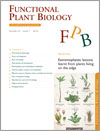
Functional Plant Biology
Volume 43 Number 7 2016
Extremophytes: Lessons Learnt from Plants Living on the Edge
FPv43n7_FOExtremophyte adaptations to salt and water deficit stress
FP15288Halophytes as a source of salt tolerance genes and mechanisms: a case study for the Salt Lake area, Turkey
Halophytes are salt tolerant plants that can live and reproduce at salt concentrations as high as sea water level. The Salt Lake area in Turkey is rich in halophyte diversity and most of these species are endemics, which can be only found around Salt Lake area in the world. This review provides information on halophytes around the Salt Lake and their tolerance mechanisms including research on the model halophyte Eutrema parvulum (Schrenk) Al-Shehbaz & Warwick, which originates from Salt Lake, Turkey.
FP15285Salt stress responses in a geographically diverse collection of Eutrema/Thellungiella spp. accessions
Salinity impairs plant growth but halophytes such as Eutrema salsugineum tolerate much higher salt concentrations than glycophytes such as Arabidopsis thaliana. We found natural variation in the salt tolerance of Eutrema accessions that was not correlated with compatible solute content. Metabolome and transcriptome analyses indicated metabolic pre-adaptation to salt stress in the halophyte and little overlap between salt-regulated genes in the two species.
FP15284Salt tolerance of the halophyte Limonium delicatulum is more associated with antioxidant enzyme activities than phenolic compounds
Antioxidant responses are key elements in the successful adaptation of halophytes to saline habitats. This study evaluated the contribution of oxidative stress components towards salinity tolerance in the salt marsh halophyte Limonium delicatulum. Results showed that antioxidant enzymes are more linked to plant tolerance than phenolic compounds. This suggests the possibility to manipulate both the content of phenols and antioxidant enzymes by increasing the salinity in the medium, to promote the medicinal uses of this halophyte.
FP16057Insights into root structure and function of Bassia indica: water redistribution and element dispersion
Root structure and function are related to environmental drivers. Investigating root system traits of the halophyte Bassia indica, we found that growth of horizontal roots towards salt is explained by a unique function: redistribution of water to allow efficient utility of nutrients in saline environment. These findings expand the current understanding of the strict connections between structure and function in roots.
FP15265Enhancing salt tolerance in quinoa by halotolerant bacterial inoculation
Plant growth-promoting bacteria (PGPB) containing specific enzymes or hormones have been successful in ameliorating salinity stress in glycophytic plants, but halophytes have not previously been tested. We analysed the effects of PGPB on quinoa – regarded as a new global crop – under salt stress. Productivity of the salt tolerant species was improved by inoculating with PGPB in salt-affected soils.
FP15213Tripogon loliiformis elicits a rapid physiological and structural response to dehydration for desiccation tolerance
This paper reports on investigations into the close relationship between the structural and physiological changes that occur during dehydration and rehydration of the resurrection grass Tripogon loliiformis. Results showed that T. loliiformis minimises dehydration-related damage through a rapid series of physiological and structural responses. Many of these changes enable the plant to regain full metabolic activity upon rehydration. These results provide powerful insights into the tolerance mechanisms of naturally resilient angiosperms and display great potential for the development of stress-tolerant crop plants.
FP15275Dry seeds and environmental extremes: consequences for seed lifespan and germination
The focus of this review is the effects of extreme environmental conditions on dry seed lifespan and germination. We discuss dry seed survival of extreme temperatures, ultraviolet radiation and ultra-drying – conditions encountered in natural environments on Earth or in the vacuum of space. We indicate gaps in knowledge and also highlight the research that is needed to discover many of the mechanisms leading to extreme tolerance of dry seeds to these environmental conditions.
FP15291Molecular and biochemical characterisation of a novel type II peroxiredoxin (XvPrx2) from the resurrection plant Xerophyta viscosa
Plant peroxiredoxins are remarkable enzymes that can detoxify reactive oxygen species (ROS) and undergo structural changes to provide chaperone activity. This study characterised a novel peroxiredoxin from the resurrection plant Xerophyta viscosa, which was associated with abiotic stress where the enzyme could protect DNA from damage and detoxify ROS. These results emphasise the importance of peroxiredoxins in tolerance mechanisms against environmental stress.
FP15278Physiological factors determine the accumulation of D-glycero-D-ido-octulose (D-g-D-i-oct) in the desiccation tolerant resurrection plant Craterostigma plantagineum
The eight carbon sugar octulose is correlated with desiccation tolerance in Craterostigma plantagineum: what happens when desiccation tolerance confronts senescence? During senescence carbohydrate and gene expression profiles change, which reflects a loss of desiccation tolerance. The synthesis of octulose is light-driven and octulose is involved in the antioxidant defence in C. plantagineum.
FP15238Differences in LEA-like 11-24 gene expression in desiccation tolerant and sensitive species of Linderniaceae are due to variations in gene promoter sequences
The aim of this study was to develop an understanding of the molecular basis for differential gene expression in desiccation-tolerant and non-desiccation tolerant plants. Although the genetic information for the stress protective LEA-like protein is contained in closely related plants, the encoded transcript accumulates to higher levels in the desiccation tolerant plants than in the non-tolerant plants. The analysis identified specific promoter response elements that are responsible for the differential expression.




